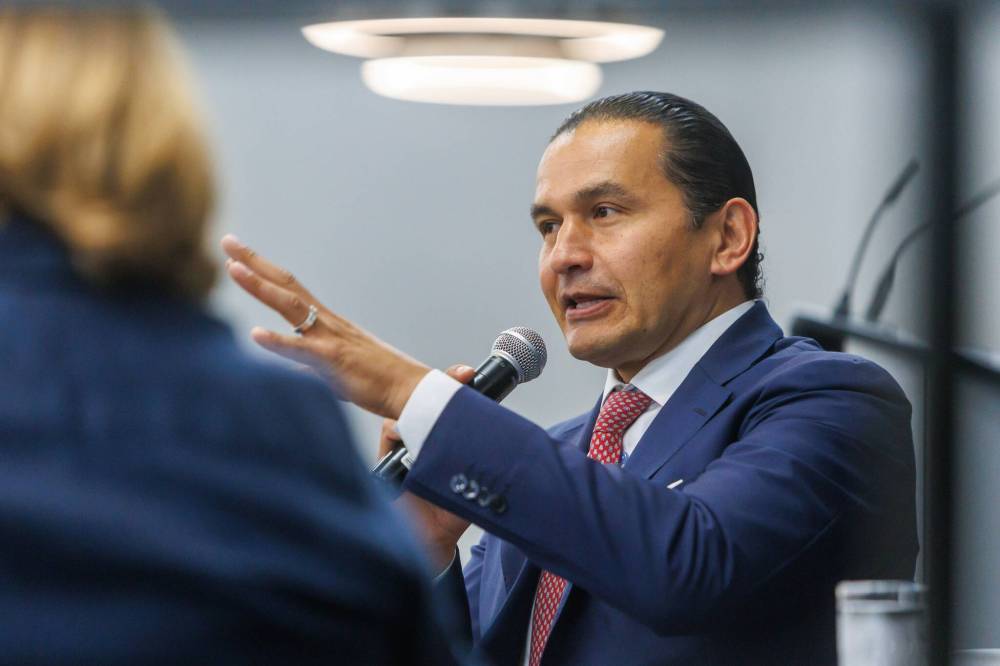We’ll be right back after this economic fantasy from Wab Kinew…
Advertisement
Read this article for free:
or
Already have an account? Log in here »
To continue reading, please subscribe:
Monthly Digital Subscription
$0 for the first 4 weeks*
- Enjoy unlimited reading on winnipegfreepress.com
- Read the E-Edition, our digital replica newspaper
- Access News Break, our award-winning app
- Play interactive puzzles
*No charge for 4 weeks then price increases to the regular rate of $19.00 plus GST every four weeks. Offer available to new and qualified returning subscribers only. Cancel any time.
Monthly Digital Subscription
$4.75/week*
- Enjoy unlimited reading on winnipegfreepress.com
- Read the E-Edition, our digital replica newspaper
- Access News Break, our award-winning app
- Play interactive puzzles
*Billed as $19 plus GST every four weeks. Cancel any time.
To continue reading, please subscribe:
Add Free Press access to your Brandon Sun subscription for only an additional
$1 for the first 4 weeks*
*Your next subscription payment will increase by $1.00 and you will be charged $16.99 plus GST for four weeks. After four weeks, your payment will increase to $23.99 plus GST every four weeks.
Read unlimited articles for free today:
or
Already have an account? Log in here »
Premier Wab Kinew says he wants Manitoba to become a “have” province by 2040. It’s a bold pledge, a catchy soundbite and it no doubt plays well politically. But the reality is, it’s more fantasy than achievable policy.
It’s not the first time Kinew has made that pledge. He reiterated it Thursday while releasing his government’s new economic development strategy.
Manitoba is one of the most heavily dependent provinces in Canada on federal equalization transfers. Just over 19 per cent of the province’s budget comes from equalization — nearly one in every five dollars the government spends.

Premier Wab Kinew (Mike Deal / Free Press)
That signals a staggering reliance on Ottawa compared with most other provinces. It isn’t something that can be shaken off in 15 years with a few modest economic development measures.
Currently, there are three “have” provinces in Canada: Alberta, Saskatchewan and British Columbia. Ontario and Newfoundland have received small equalization payments on and off over the past 10 years. Manitoba is far behind all of those provinces economically.
Which is why it receives the highest per capita equalization payments in Canada west of New Brunswick. The province takes in more than double what Quebec receives per person.
That alone illustrates how far behind Manitoba is economically. Equalization isn’t some small top-up — it’s the lifeblood of the provincial government’s finances. It’s distributed based on provinces’ relative fiscal capacity.
If Manitoba were anywhere close to the Canadian average in terms of economic strength, maybe there would be a case to be made. But the numbers paint a very different picture.
Manitoba’s GDP per capita in 2024 was $47,520. The average of all provinces was $52,218. That might not sound like a massive gap at first glance, but it puts Manitoba seventh out of 10 provinces.
Worse yet, the gulf between Manitoba and the three “have” provinces is significant. Their average GDP per capita in 2024 was $63,660 — over a third higher than Manitoba’s. Alberta leads the pack at $71,639.
This isn’t a gap that can be closed with minor tax incentives for investment or a handful of new training programs. It’s structural. Manitoba’s economy is fundamentally weaker than the “have” provinces. Absent a seismic shift in the province’s economic foundation, that won’t change anytime soon.
One of the main reasons Alberta, Saskatchewan and B.C. can boast stronger economies is their resource wealth. Oil, gas, potash and other natural resources provide enormous royalty revenues and attract huge private-sector investments.
Manitoba, while well diversified economically and relatively stable, simply doesn’t have the same level of resources to exploit. Manitoba Hydro is an asset, but it doesn’t generate anywhere near the windfall revenues of oil and gas.
So when the premier talks about making Manitoba a “have” province, it ignores this fundamental economic reality.
The Kinew government’s new economic development plan does include some sensible measures: investments in skills training, a focus on attracting more private investment and efforts to grow the tech and green-energy sectors. Those are all fine ideas, but they’re incremental steps.
They might help boost GDP growth slightly. They might create a few thousand jobs here and there. But they won’t catapult Manitoba’s GDP to “have” status.
This week’s economic plan feels more like a political document than a serious road map to prosperity. Governments of all stripes have rolled out similar strategies in the past by focusing on innovation, boosting immigration and supporting small business — and the results have been modest, at best.
There’s nothing wrong with setting ambitious goals. Governments should aspire to improve the province’s fortunes. But promising Manitobans that the province can shed equalization payments by 2040 is unrealistic. It creates false hope, suggesting there’s a magic-bullet solution when there isn’t.
The danger is that it distracts from the real work that needs to be done: improving the fundamentals. That means managing public finances responsibly, getting health care under control, fixing education outcomes and ensuring the province has a competitive tax and regulatory environment. Those things may not vault Manitoba into “have” status, but they will make life better for Manitobans.
Manitoba has strengths — affordable housing, a relatively stable economy and a strong public sector. Those strengths won’t suddenly transform it into “have” status — and that’s fine.
There’s no shame in being a “have-not” province. Equalization exists for a reason: to ensure all Canadians, no matter where they live, have access to similar levels of public services at similar levels of taxation. Manitoba benefits from that arrangement, which is funded entirely by federal taxation.
The real issue for Manitoba when it comes to equalization is how it uses that money. It should be used to ensure people have the best quality of life possible.
Manitoba has received massive increases in equalization over the past several years. Unfortunately, both the NDP and the former Progressive Conservative government have frittered most of that away in tax cuts, while running massive deficits.
Manitoba deserves a government that’s ambitious but honest, visionary but grounded in reality. Pledging to become a “have” promise by 2040 is anything but that. On this one, Kinew has chosen rhetoric over realism.
tom.brodbeck@freepress.mb.ca

Tom Brodbeck is an award-winning author and columnist with over 30 years experience in print media. He joined the Free Press in 2019. Born and raised in Montreal, Tom graduated from the University of Manitoba in 1993 with a Bachelor of Arts degree in economics and commerce. Read more about Tom.
Tom provides commentary and analysis on political and related issues at the municipal, provincial and federal level. His columns are built on research and coverage of local events. The Free Press’s editing team reviews Tom’s columns before they are posted online or published in print – part of the Free Press’s tradition, since 1872, of producing reliable independent journalism. Read more about Free Press’s history and mandate, and learn how our newsroom operates.
Our newsroom depends on a growing audience of readers to power our journalism. If you are not a paid reader, please consider becoming a subscriber.
Our newsroom depends on its audience of readers to power our journalism. Thank you for your support.





